BMP3004 - Employee Motivation: Factors, Experiences and Strategies
VerifiedAdded on 2023/06/14
|7
|1842
|51
Report
AI Summary
This report provides a comprehensive analysis of employee motivation in the workplace, examining various factors that influence employees' dedication and performance. It delves into motivation theories, such as Maslow's hierarchy of needs, and differentiates between intrinsic and extrinsic motivation. The report identifies key motivators like salary, promotion opportunities, and a positive work environment. It also addresses the positive experiences personnel gain through skill development and modern performance management, as well as the negative experiences stemming from workplace conflicts and toxic environments. Furthermore, it outlines strategies for coping with negative factors, including providing opportunities for employees to express opinions and enhancing employee engagement. The conclusion emphasizes the significant role of motivation in achieving company goals and suggests practical approaches for organizations to foster a more positive and productive work environment.
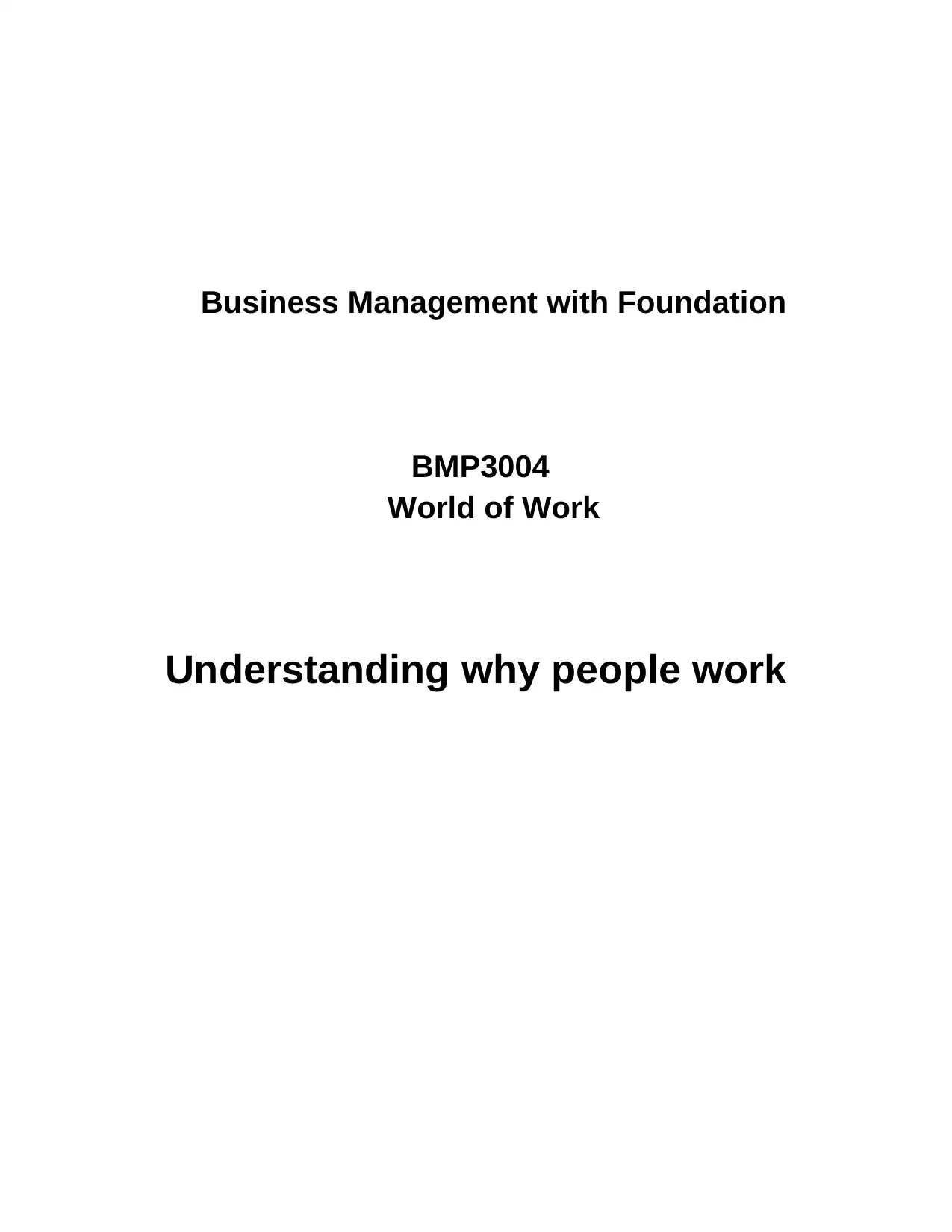
Business Management with Foundation
BMP3004
World of Work
Understanding why people work
BMP3004
World of Work
Understanding why people work
Paraphrase This Document
Need a fresh take? Get an instant paraphrase of this document with our AI Paraphraser
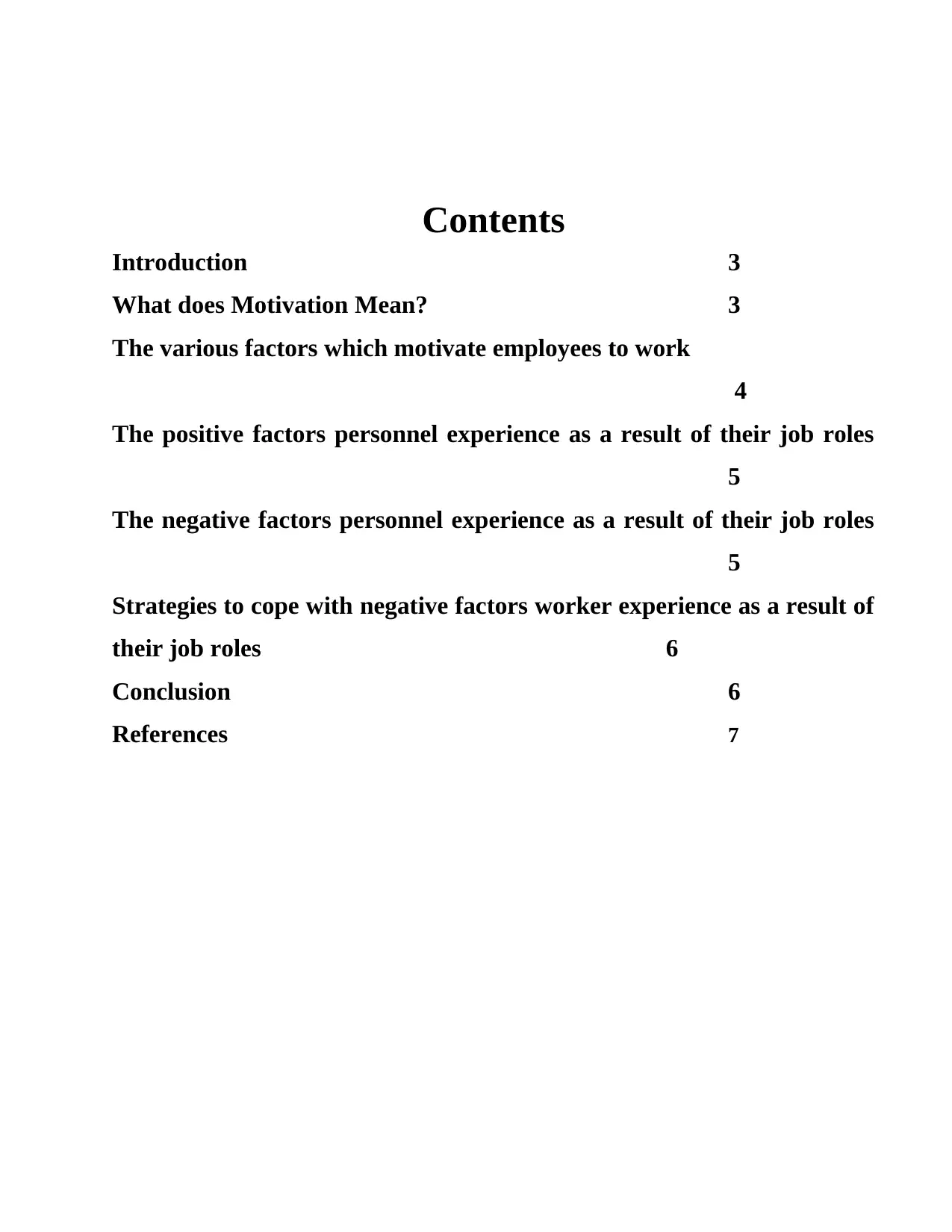
Contents
Introduction 3
What does Motivation Mean? 3
The various factors which motivate employees to work
4
The positive factors personnel experience as a result of their job roles
5
The negative factors personnel experience as a result of their job roles
5
Strategies to cope with negative factors worker experience as a result of
their job roles 6
Conclusion 6
References 7
Introduction 3
What does Motivation Mean? 3
The various factors which motivate employees to work
4
The positive factors personnel experience as a result of their job roles
5
The negative factors personnel experience as a result of their job roles
5
Strategies to cope with negative factors worker experience as a result of
their job roles 6
Conclusion 6
References 7
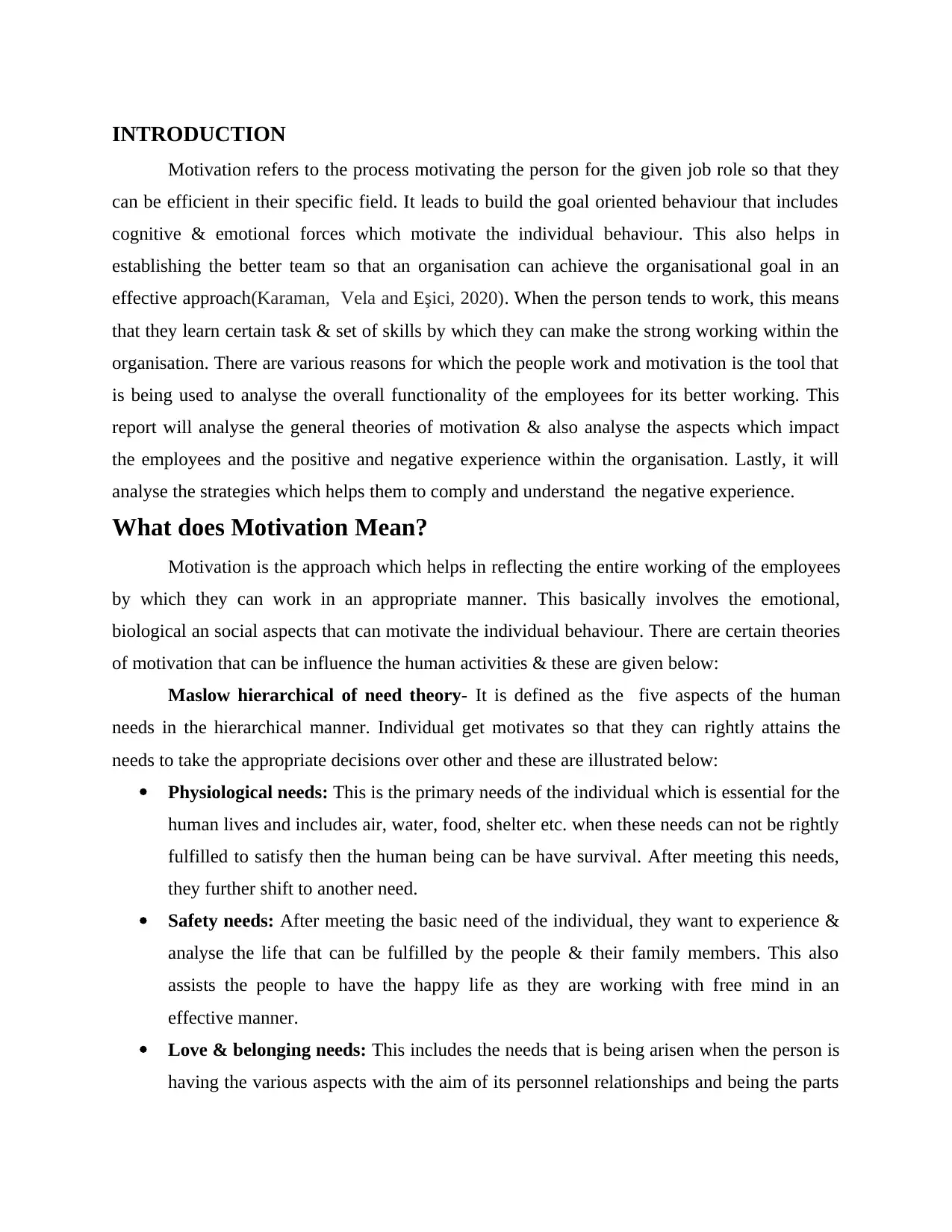
INTRODUCTION
Motivation refers to the process motivating the person for the given job role so that they
can be efficient in their specific field. It leads to build the goal oriented behaviour that includes
cognitive & emotional forces which motivate the individual behaviour. This also helps in
establishing the better team so that an organisation can achieve the organisational goal in an
effective approach(Karaman, Vela and Eşici, 2020). When the person tends to work, this means
that they learn certain task & set of skills by which they can make the strong working within the
organisation. There are various reasons for which the people work and motivation is the tool that
is being used to analyse the overall functionality of the employees for its better working. This
report will analyse the general theories of motivation & also analyse the aspects which impact
the employees and the positive and negative experience within the organisation. Lastly, it will
analyse the strategies which helps them to comply and understand the negative experience.
What does Motivation Mean?
Motivation is the approach which helps in reflecting the entire working of the employees
by which they can work in an appropriate manner. This basically involves the emotional,
biological an social aspects that can motivate the individual behaviour. There are certain theories
of motivation that can be influence the human activities & these are given below:
Maslow hierarchical of need theory- It is defined as the five aspects of the human
needs in the hierarchical manner. Individual get motivates so that they can rightly attains the
needs to take the appropriate decisions over other and these are illustrated below:
Physiological needs: This is the primary needs of the individual which is essential for the
human lives and includes air, water, food, shelter etc. when these needs can not be rightly
fulfilled to satisfy then the human being can be have survival. After meeting this needs,
they further shift to another need.
Safety needs: After meeting the basic need of the individual, they want to experience &
analyse the life that can be fulfilled by the people & their family members. This also
assists the people to have the happy life as they are working with free mind in an
effective manner.
Love & belonging needs: This includes the needs that is being arisen when the person is
having the various aspects with the aim of its personnel relationships and being the parts
Motivation refers to the process motivating the person for the given job role so that they
can be efficient in their specific field. It leads to build the goal oriented behaviour that includes
cognitive & emotional forces which motivate the individual behaviour. This also helps in
establishing the better team so that an organisation can achieve the organisational goal in an
effective approach(Karaman, Vela and Eşici, 2020). When the person tends to work, this means
that they learn certain task & set of skills by which they can make the strong working within the
organisation. There are various reasons for which the people work and motivation is the tool that
is being used to analyse the overall functionality of the employees for its better working. This
report will analyse the general theories of motivation & also analyse the aspects which impact
the employees and the positive and negative experience within the organisation. Lastly, it will
analyse the strategies which helps them to comply and understand the negative experience.
What does Motivation Mean?
Motivation is the approach which helps in reflecting the entire working of the employees
by which they can work in an appropriate manner. This basically involves the emotional,
biological an social aspects that can motivate the individual behaviour. There are certain theories
of motivation that can be influence the human activities & these are given below:
Maslow hierarchical of need theory- It is defined as the five aspects of the human
needs in the hierarchical manner. Individual get motivates so that they can rightly attains the
needs to take the appropriate decisions over other and these are illustrated below:
Physiological needs: This is the primary needs of the individual which is essential for the
human lives and includes air, water, food, shelter etc. when these needs can not be rightly
fulfilled to satisfy then the human being can be have survival. After meeting this needs,
they further shift to another need.
Safety needs: After meeting the basic need of the individual, they want to experience &
analyse the life that can be fulfilled by the people & their family members. This also
assists the people to have the happy life as they are working with free mind in an
effective manner.
Love & belonging needs: This includes the needs that is being arisen when the person is
having the various aspects with the aim of its personnel relationships and being the parts
⊘ This is a preview!⊘
Do you want full access?
Subscribe today to unlock all pages.

Trusted by 1+ million students worldwide
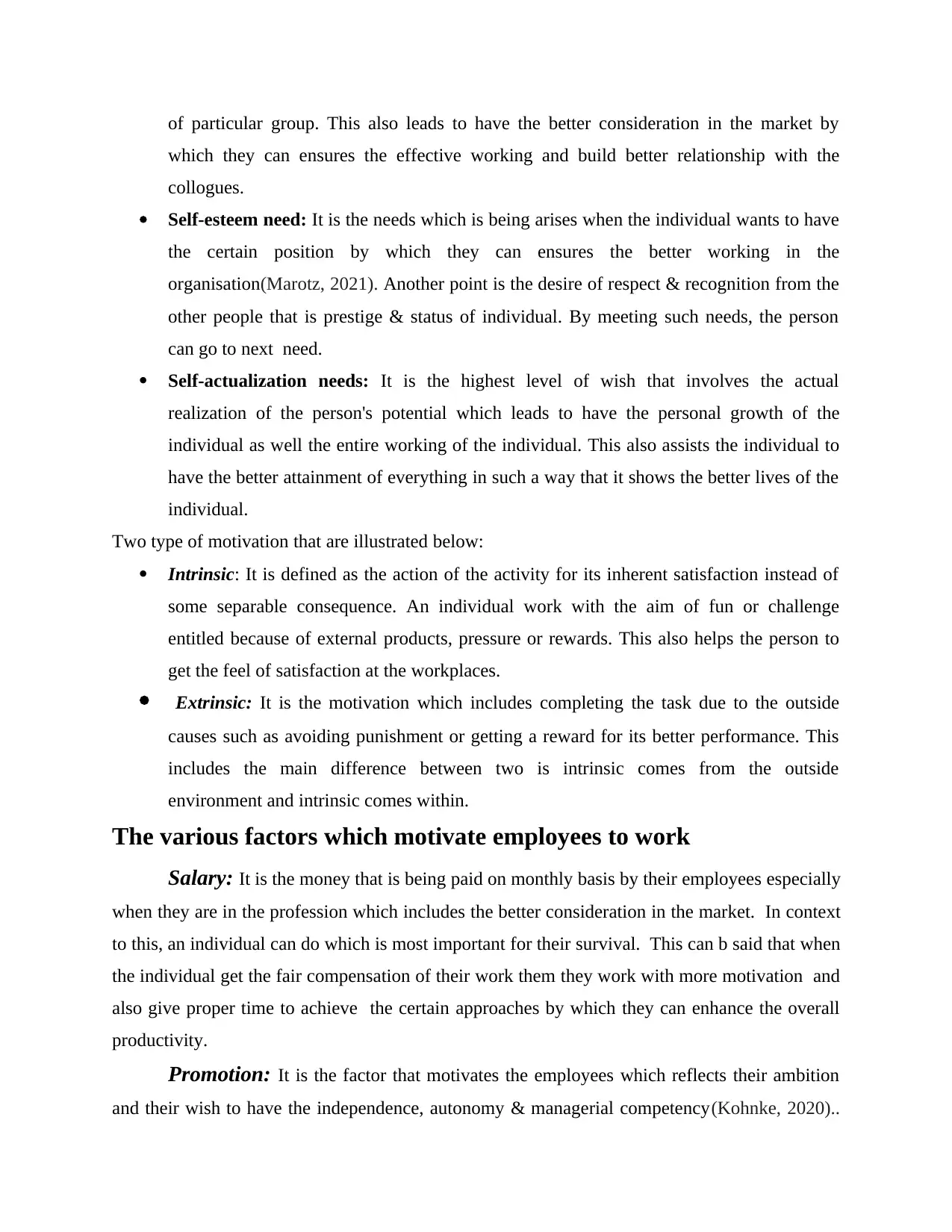
of particular group. This also leads to have the better consideration in the market by
which they can ensures the effective working and build better relationship with the
collogues.
Self-esteem need: It is the needs which is being arises when the individual wants to have
the certain position by which they can ensures the better working in the
organisation(Marotz, 2021). Another point is the desire of respect & recognition from the
other people that is prestige & status of individual. By meeting such needs, the person
can go to next need.
Self-actualization needs: It is the highest level of wish that involves the actual
realization of the person's potential which leads to have the personal growth of the
individual as well the entire working of the individual. This also assists the individual to
have the better attainment of everything in such a way that it shows the better lives of the
individual.
Two type of motivation that are illustrated below:
Intrinsic: It is defined as the action of the activity for its inherent satisfaction instead of
some separable consequence. An individual work with the aim of fun or challenge
entitled because of external products, pressure or rewards. This also helps the person to
get the feel of satisfaction at the workplaces.
Extrinsic: It is the motivation which includes completing the task due to the outside
causes such as avoiding punishment or getting a reward for its better performance. This
includes the main difference between two is intrinsic comes from the outside
environment and intrinsic comes within.
The various factors which motivate employees to work
Salary: It is the money that is being paid on monthly basis by their employees especially
when they are in the profession which includes the better consideration in the market. In context
to this, an individual can do which is most important for their survival. This can b said that when
the individual get the fair compensation of their work them they work with more motivation and
also give proper time to achieve the certain approaches by which they can enhance the overall
productivity.
Promotion: It is the factor that motivates the employees which reflects their ambition
and their wish to have the independence, autonomy & managerial competency(Kohnke, 2020)..
which they can ensures the effective working and build better relationship with the
collogues.
Self-esteem need: It is the needs which is being arises when the individual wants to have
the certain position by which they can ensures the better working in the
organisation(Marotz, 2021). Another point is the desire of respect & recognition from the
other people that is prestige & status of individual. By meeting such needs, the person
can go to next need.
Self-actualization needs: It is the highest level of wish that involves the actual
realization of the person's potential which leads to have the personal growth of the
individual as well the entire working of the individual. This also assists the individual to
have the better attainment of everything in such a way that it shows the better lives of the
individual.
Two type of motivation that are illustrated below:
Intrinsic: It is defined as the action of the activity for its inherent satisfaction instead of
some separable consequence. An individual work with the aim of fun or challenge
entitled because of external products, pressure or rewards. This also helps the person to
get the feel of satisfaction at the workplaces.
Extrinsic: It is the motivation which includes completing the task due to the outside
causes such as avoiding punishment or getting a reward for its better performance. This
includes the main difference between two is intrinsic comes from the outside
environment and intrinsic comes within.
The various factors which motivate employees to work
Salary: It is the money that is being paid on monthly basis by their employees especially
when they are in the profession which includes the better consideration in the market. In context
to this, an individual can do which is most important for their survival. This can b said that when
the individual get the fair compensation of their work them they work with more motivation and
also give proper time to achieve the certain approaches by which they can enhance the overall
productivity.
Promotion: It is the factor that motivates the employees which reflects their ambition
and their wish to have the independence, autonomy & managerial competency(Kohnke, 2020)..
Paraphrase This Document
Need a fresh take? Get an instant paraphrase of this document with our AI Paraphraser
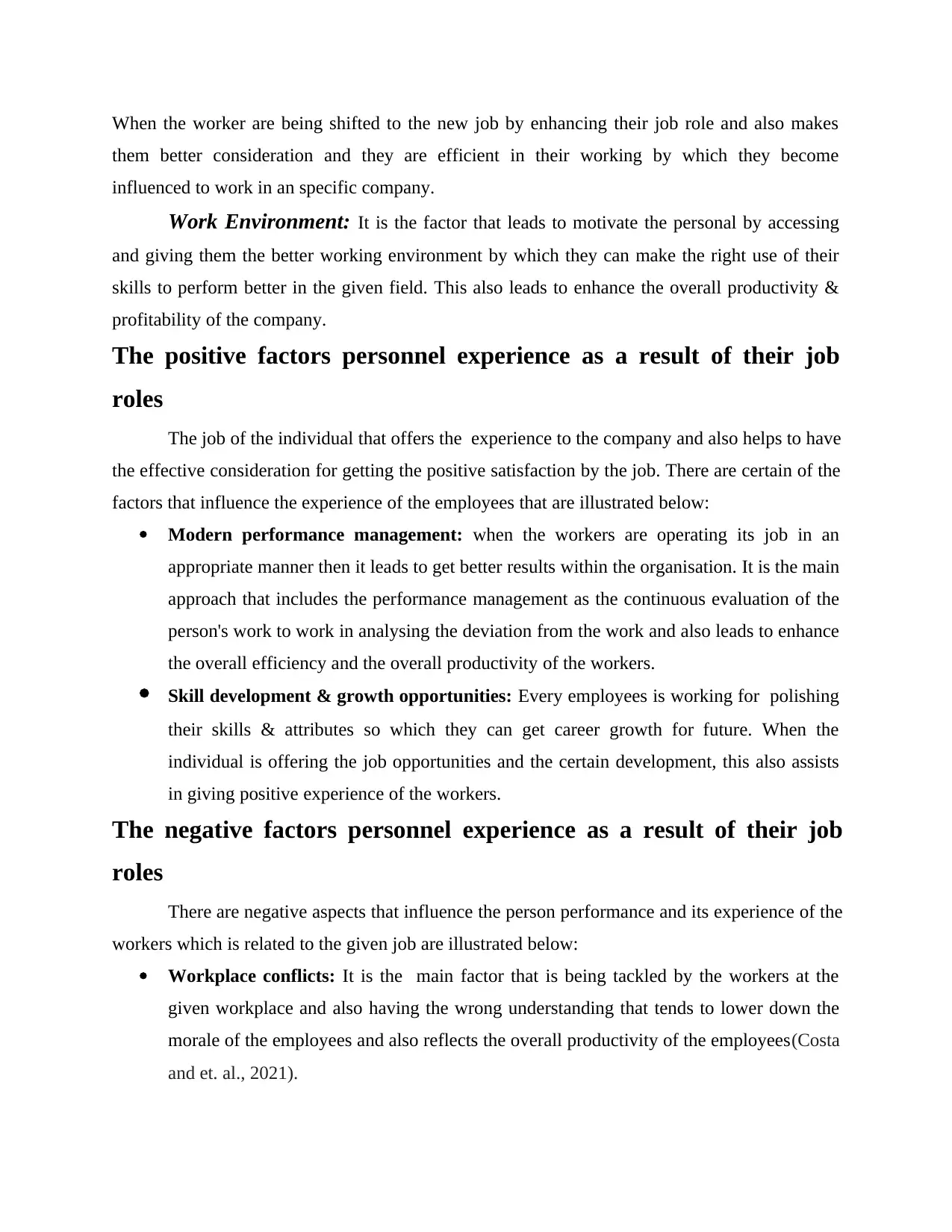
When the worker are being shifted to the new job by enhancing their job role and also makes
them better consideration and they are efficient in their working by which they become
influenced to work in an specific company.
Work Environment: It is the factor that leads to motivate the personal by accessing
and giving them the better working environment by which they can make the right use of their
skills to perform better in the given field. This also leads to enhance the overall productivity &
profitability of the company.
The positive factors personnel experience as a result of their job
roles
The job of the individual that offers the experience to the company and also helps to have
the effective consideration for getting the positive satisfaction by the job. There are certain of the
factors that influence the experience of the employees that are illustrated below:
Modern performance management: when the workers are operating its job in an
appropriate manner then it leads to get better results within the organisation. It is the main
approach that includes the performance management as the continuous evaluation of the
person's work to work in analysing the deviation from the work and also leads to enhance
the overall efficiency and the overall productivity of the workers.
Skill development & growth opportunities: Every employees is working for polishing
their skills & attributes so which they can get career growth for future. When the
individual is offering the job opportunities and the certain development, this also assists
in giving positive experience of the workers.
The negative factors personnel experience as a result of their job
roles
There are negative aspects that influence the person performance and its experience of the
workers which is related to the given job are illustrated below:
Workplace conflicts: It is the main factor that is being tackled by the workers at the
given workplace and also having the wrong understanding that tends to lower down the
morale of the employees and also reflects the overall productivity of the employees(Costa
and et. al., 2021).
them better consideration and they are efficient in their working by which they become
influenced to work in an specific company.
Work Environment: It is the factor that leads to motivate the personal by accessing
and giving them the better working environment by which they can make the right use of their
skills to perform better in the given field. This also leads to enhance the overall productivity &
profitability of the company.
The positive factors personnel experience as a result of their job
roles
The job of the individual that offers the experience to the company and also helps to have
the effective consideration for getting the positive satisfaction by the job. There are certain of the
factors that influence the experience of the employees that are illustrated below:
Modern performance management: when the workers are operating its job in an
appropriate manner then it leads to get better results within the organisation. It is the main
approach that includes the performance management as the continuous evaluation of the
person's work to work in analysing the deviation from the work and also leads to enhance
the overall efficiency and the overall productivity of the workers.
Skill development & growth opportunities: Every employees is working for polishing
their skills & attributes so which they can get career growth for future. When the
individual is offering the job opportunities and the certain development, this also assists
in giving positive experience of the workers.
The negative factors personnel experience as a result of their job
roles
There are negative aspects that influence the person performance and its experience of the
workers which is related to the given job are illustrated below:
Workplace conflicts: It is the main factor that is being tackled by the workers at the
given workplace and also having the wrong understanding that tends to lower down the
morale of the employees and also reflects the overall productivity of the employees(Costa
and et. al., 2021).
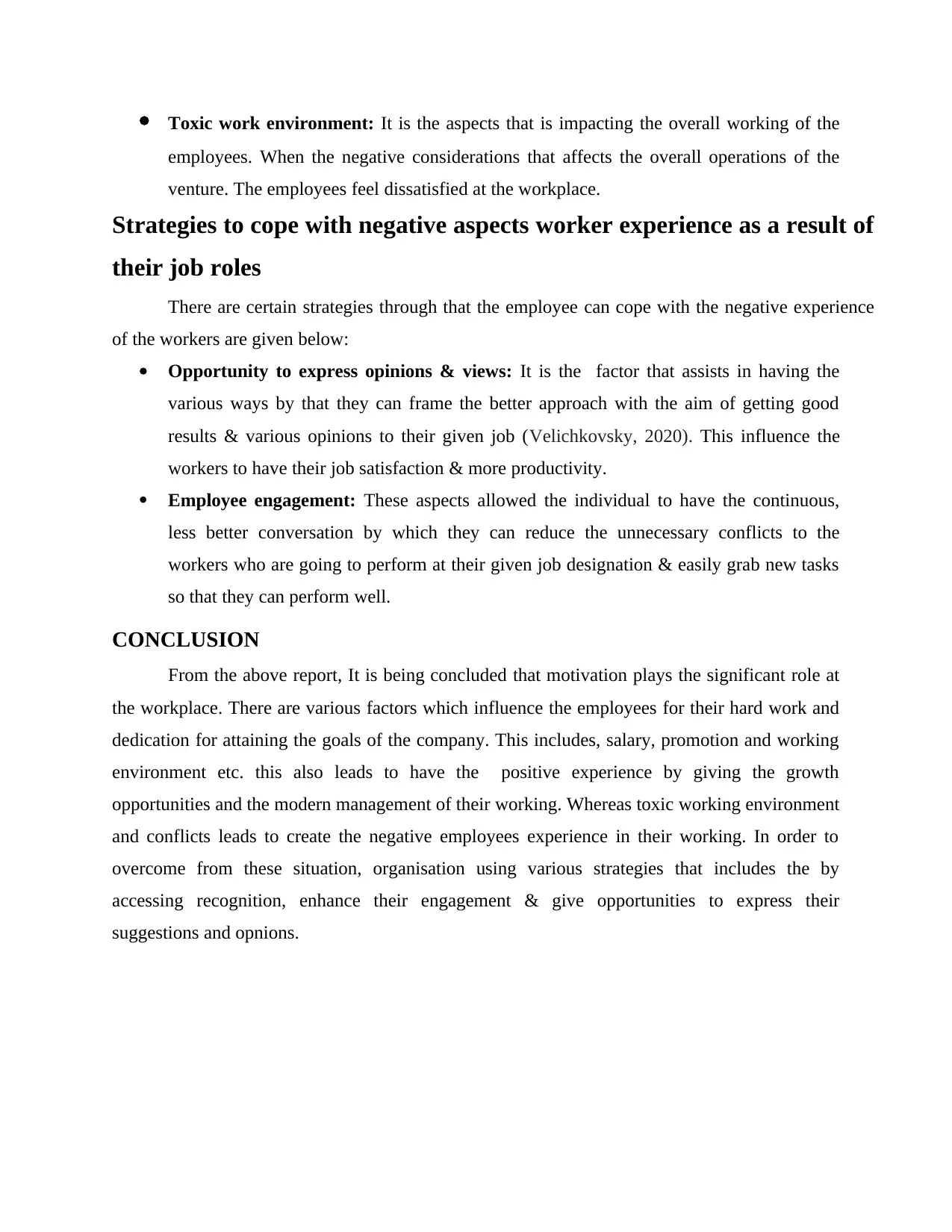
Toxic work environment: It is the aspects that is impacting the overall working of the
employees. When the negative considerations that affects the overall operations of the
venture. The employees feel dissatisfied at the workplace.
Strategies to cope with negative aspects worker experience as a result of
their job roles
There are certain strategies through that the employee can cope with the negative experience
of the workers are given below:
Opportunity to express opinions & views: It is the factor that assists in having the
various ways by that they can frame the better approach with the aim of getting good
results & various opinions to their given job (Velichkovsky, 2020). This influence the
workers to have their job satisfaction & more productivity.
Employee engagement: These aspects allowed the individual to have the continuous,
less better conversation by which they can reduce the unnecessary conflicts to the
workers who are going to perform at their given job designation & easily grab new tasks
so that they can perform well.
CONCLUSION
From the above report, It is being concluded that motivation plays the significant role at
the workplace. There are various factors which influence the employees for their hard work and
dedication for attaining the goals of the company. This includes, salary, promotion and working
environment etc. this also leads to have the positive experience by giving the growth
opportunities and the modern management of their working. Whereas toxic working environment
and conflicts leads to create the negative employees experience in their working. In order to
overcome from these situation, organisation using various strategies that includes the by
accessing recognition, enhance their engagement & give opportunities to express their
suggestions and opnions.
employees. When the negative considerations that affects the overall operations of the
venture. The employees feel dissatisfied at the workplace.
Strategies to cope with negative aspects worker experience as a result of
their job roles
There are certain strategies through that the employee can cope with the negative experience
of the workers are given below:
Opportunity to express opinions & views: It is the factor that assists in having the
various ways by that they can frame the better approach with the aim of getting good
results & various opinions to their given job (Velichkovsky, 2020). This influence the
workers to have their job satisfaction & more productivity.
Employee engagement: These aspects allowed the individual to have the continuous,
less better conversation by which they can reduce the unnecessary conflicts to the
workers who are going to perform at their given job designation & easily grab new tasks
so that they can perform well.
CONCLUSION
From the above report, It is being concluded that motivation plays the significant role at
the workplace. There are various factors which influence the employees for their hard work and
dedication for attaining the goals of the company. This includes, salary, promotion and working
environment etc. this also leads to have the positive experience by giving the growth
opportunities and the modern management of their working. Whereas toxic working environment
and conflicts leads to create the negative employees experience in their working. In order to
overcome from these situation, organisation using various strategies that includes the by
accessing recognition, enhance their engagement & give opportunities to express their
suggestions and opnions.
⊘ This is a preview!⊘
Do you want full access?
Subscribe today to unlock all pages.

Trusted by 1+ million students worldwide
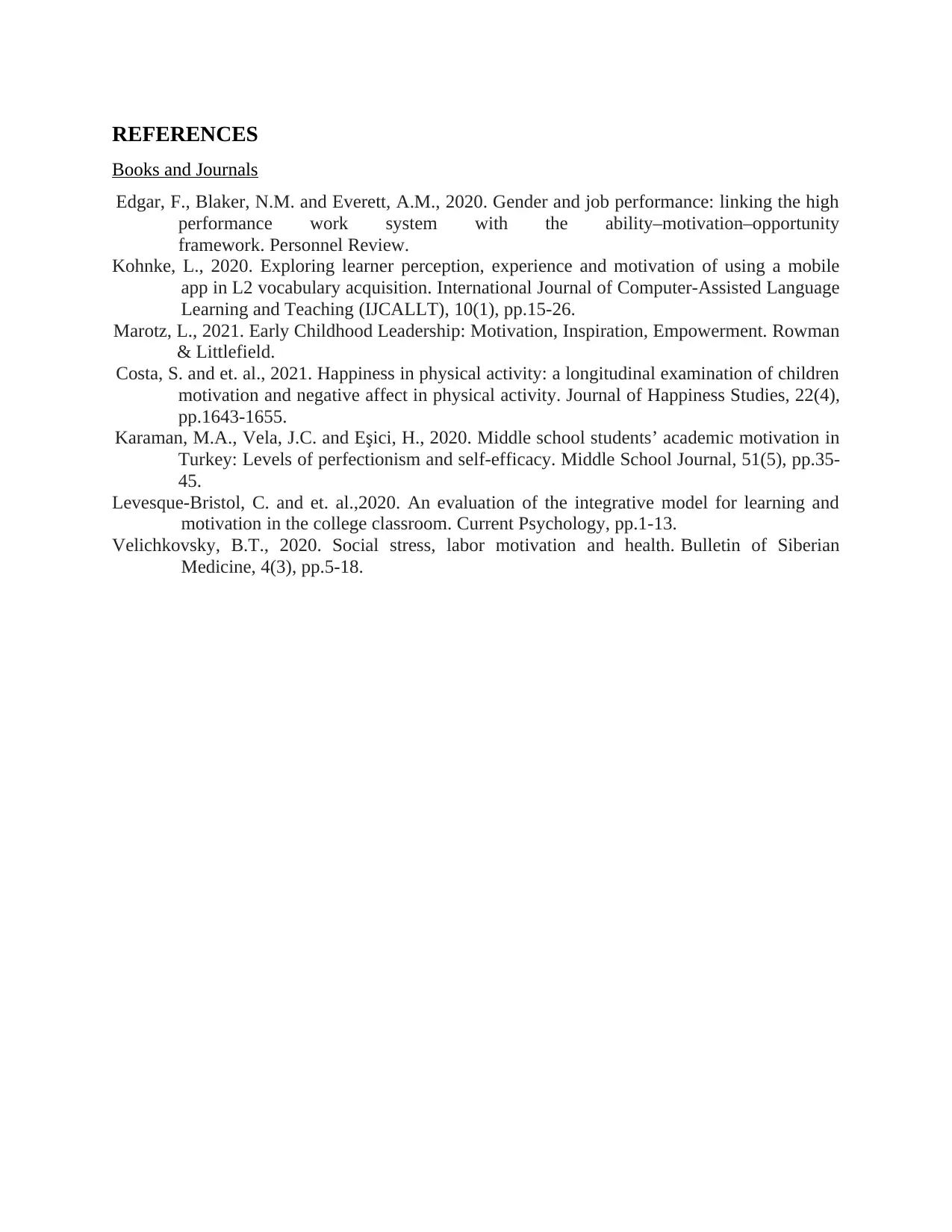
REFERENCES
Books and Journals
Edgar, F., Blaker, N.M. and Everett, A.M., 2020. Gender and job performance: linking the high
performance work system with the ability–motivation–opportunity
framework. Personnel Review.
Kohnke, L., 2020. Exploring learner perception, experience and motivation of using a mobile
app in L2 vocabulary acquisition. International Journal of Computer-Assisted Language
Learning and Teaching (IJCALLT), 10(1), pp.15-26.
Marotz, L., 2021. Early Childhood Leadership: Motivation, Inspiration, Empowerment. Rowman
& Littlefield.
Costa, S. and et. al., 2021. Happiness in physical activity: a longitudinal examination of children
motivation and negative affect in physical activity. Journal of Happiness Studies, 22(4),
pp.1643-1655.
Karaman, M.A., Vela, J.C. and Eşici, H., 2020. Middle school students’ academic motivation in
Turkey: Levels of perfectionism and self-efficacy. Middle School Journal, 51(5), pp.35-
45.
Levesque-Bristol, C. and et. al.,2020. An evaluation of the integrative model for learning and
motivation in the college classroom. Current Psychology, pp.1-13.
Velichkovsky, B.T., 2020. Social stress, labor motivation and health. Bulletin of Siberian
Medicine, 4(3), pp.5-18.
Books and Journals
Edgar, F., Blaker, N.M. and Everett, A.M., 2020. Gender and job performance: linking the high
performance work system with the ability–motivation–opportunity
framework. Personnel Review.
Kohnke, L., 2020. Exploring learner perception, experience and motivation of using a mobile
app in L2 vocabulary acquisition. International Journal of Computer-Assisted Language
Learning and Teaching (IJCALLT), 10(1), pp.15-26.
Marotz, L., 2021. Early Childhood Leadership: Motivation, Inspiration, Empowerment. Rowman
& Littlefield.
Costa, S. and et. al., 2021. Happiness in physical activity: a longitudinal examination of children
motivation and negative affect in physical activity. Journal of Happiness Studies, 22(4),
pp.1643-1655.
Karaman, M.A., Vela, J.C. and Eşici, H., 2020. Middle school students’ academic motivation in
Turkey: Levels of perfectionism and self-efficacy. Middle School Journal, 51(5), pp.35-
45.
Levesque-Bristol, C. and et. al.,2020. An evaluation of the integrative model for learning and
motivation in the college classroom. Current Psychology, pp.1-13.
Velichkovsky, B.T., 2020. Social stress, labor motivation and health. Bulletin of Siberian
Medicine, 4(3), pp.5-18.
1 out of 7
Related Documents
Your All-in-One AI-Powered Toolkit for Academic Success.
+13062052269
info@desklib.com
Available 24*7 on WhatsApp / Email
![[object Object]](/_next/static/media/star-bottom.7253800d.svg)
Unlock your academic potential
Copyright © 2020–2025 A2Z Services. All Rights Reserved. Developed and managed by ZUCOL.


